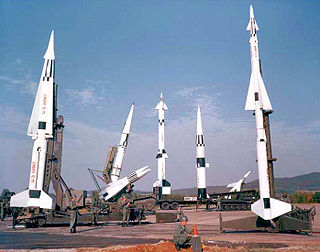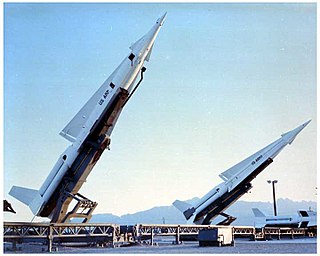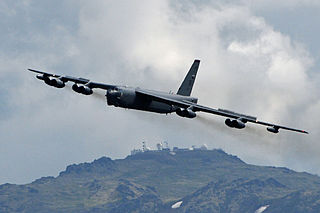
Project Nike was a U.S. Army project, proposed in May 1945 by Bell Laboratories, to develop a line-of-sight anti-aircraft missile system. The project delivered the United States' first operational anti-aircraft missile system, the Nike Ajax, in 1953. A great number of the technologies and rocket systems used for developing the Nike Ajax were re-used for a number of functions, many of which were given the "Nike" name . The missile's first-stage solid rocket booster became the basis for many types of rocket including the Nike Hercules missile and NASA's Nike Smoke rocket, used for upper-atmosphere research.

White Sands Missile Range (WSMR) is a United States Army military testing area and firing range located in the US state of New Mexico. The range was originally established in 1941 as the Alamogordo Bombing and Gunnery Range, where the Trinity test site lay at the northern end of the Range, in Socorro County near the towns of Carrizozo and San Antonio. It then became the White Sands Proving Ground on 9 July 1945.

The Nike Hercules, initially designated SAM-A-25 and later MIM-14, was a surface-to-air missile (SAM) used by U.S. and NATO armed forces for medium- and high-altitude long-range air defense. It was normally armed with the W31 nuclear warhead, but could also be fitted with a conventional warhead for export use. Its warhead also allowed it to be used in a secondary surface-to-surface role, and the system also demonstrated its ability to hit other short-range missiles in flight.

SF-88 is a former Nike Missile launch site at Fort Barry, in the Marin Headlands to the north of San Francisco, California, United States. Opened in 1954, the site was intended to protect the population and military installations of the San Francisco Bay Area during the Cold War, specifically from attack by Soviet bomber aircraft.

Fort Hancock is a former United States Army fort at Sandy Hook in Atlantic Highlands New Jersey. The coastal artillery base defended the Atlantic coast and the entrance to New York Harbor, with its first gun batteries operational in 1896. The fort served from then until 1950 as part of the Harbor Defenses of New York and predecessor organizations. Between 1874 and 1919, the adjacent US Army Sandy Hook Proving Ground was operated in conjunction with Fort Hancock. It is now part of Fort Hancock Memorial Park. It was preceded by the Fort at Sandy Hook, built 1857–1867 and demolished beginning in 1885.

Fort MacArthur is a former United States Army installation in San Pedro, Los Angeles, California. A small section remains in military use by the United States Air Force as a housing and administrative annex of Los Angeles Air Force Base. The fort is named after Lieutenant General Arthur MacArthur. His son, Douglas MacArthur, would later command American forces in the Pacific during World War II.

The 32d Air Division is an inactive United States Air Force organization. It was last active with Air Defense Command, assigned to First Air Force at Gunter Air Force Base, Alabama, where it was inactivated on 31 December 1969.

Highlands Air Force Station was a military installation in Middletown Township near the borough of Highlands, New Jersey. The station provided ground-controlled interception radar coverage as part of the Lashup Radar Network and the Semi-Automatic Ground Environment network, as well as providing radar coverage for the Highlands Army Air Defense Site. The site's 240 acres (97 ha) is now the Rocky Point section in Hartshorne Woods Park of the Monmouth County Parks System.
The Martin AN/FSG-1 Antiaircraft Defense System, better known as Missile Master, was an electronic fire distribution center to computerize Cold War air defense (AD) command posts from manual plotting board operations to automated command and control of remote surface-to-air missile (SAM) launch batteries. The 10 United States Army C3 systems used radar netting ("electronic umbrella") at Missile Master military installations for coordinating ground-controlled interception by Nike and MIM-23 Hawk missiles. The vacuum tube fire control logic reduced the time to designate the appropriate missile battery to launch if an enemy target had intruded into a defense area where an AN/FSG-1 system was deployed.
The Hughes AN/TSQ-51 Air Defense Command and Coordination System was a transportable electronic fire distribution center for automated command and control of remote Nike missile launch batteries. The radar netting system replace the vacuum tube AN/FSG-1 in 6 United States Missile Master bunkers after the upgrade was approved by the United States Department of Defense in 1963; and additional deployments were at Homestead-Miami, Florida, and Providence, Rhode Island, to replace Battery Integration and Radar DIsplay Equipment (BIRDIE) systems; as well as at San Francisco. As with the AN/FSG-1, the AN/TSQ-51 could provide fire control for 24 Nike batteries, but the smaller AN/TSQ-51 could be fielded in 2 trailers.

Missile Master was a US Army surface-to-air missile control complex/facility. It controlled Project Nike missiles. Virtually all Missile Masters had a bunker housing the Martin AN/FSG-1 Antiaircraft Defense System, as well as additional structures for "an AN/FPS-33 defense acquisition radar (DAR) or similar radar, two height-finder radars," and identification friend or foe secondary radar. The radars, along with Automated Data Links (ADL) from remote Nike firing units, provided data into the AN/FSG-1 tracking subsystem with the DAR providing surveillance coverage to about 200 mi (320 km).
The Martin AN/GSG-5 Battery Integration and Radar DIsplay Equipment (BIRDIE) was a transportable electronic fire distribution center for automated command and control of remote surface-to-air missile launch batteries. The solid state radar netting system replaced the vacuum tube AN/FSG-1 at 3 United States Missile Master bunkers and BIRDIEs were deployed at over 25 US locations including Homestead-Miami, Florida; Providence, Rhode Island; and San Francisco. The AN/GSG-5 with 3 consoles was a direction center for up to 16 Nike missile batteries, but a smaller variant with only 1 console and without computer and storage equipment could control only 2 batteries and was the 1st BIRDIE deployed. Several BIRDIE systems were replaced by Hughes AN/TSQ-51 Air Defense Command and Coordination Systems, and the last AADCP with an AN/GSG-5 was at Ft Lawton on July 1, 1973.

The Selfridge AFB radar station is a United States military facility in Michigan. It began operations in 1949 with a Bendix AN/CPS-5 Radar test that tracked aircraft at 210 mi (340 km). A height finder MIT AN/CPS-4 Radar was added by March 9, 1950; and the station was site L-17 of the Lashup Radar Network and site LP-17 of the subsequent network during construction of the Air Defense Command permanent network. The 661st Aircraft Control and Warning Squadron was activated at Selfridge in 1951, and with a pair of General Electric AN/CPS-6 Radars, the station became site LP-20 of the permanent ADC network in 1952. In 1957 the station added a height finder General Electric AN/FPS-6 Radar. The station became part of the Semi Automatic Ground Environment radar network in 1959, supplying radar tracks to SAGE data center DC-06 at Custer Air Force Station, Michigan, for directing interceptor aircraft and CIM-10 Bomarc air defense missiles.

The Western Electric System 1393 Radar Course Directing Central (RCDC) was a Cold War complex of radar/computer systems within the overall Improved Nike Hercules Air Defense Guided Missile System. The RCDC was installed at the "battery control areas" of ~5 hectares each which was for commanding a nearby missile Launching Area (LA), firing a missile from the LA, and guiding a launched missile to a burst point near an enemy aircraft.

The Nike Ajax was an American guided surface-to-air missile (SAM) developed by Bell Labs for the United States Army. The world's first operational guided surface-to-air missile, the Nike Ajax was designed to attack conventional bomber aircraft flying at high subsonic speeds and altitudes above 50,000 feet (15 km). Nike entered service in 1954 and was initially deployed within the United States to defend against potential Soviet bomber attacks, though it was later deployed overseas to protect US military bases, and was also sold to various allied militaries. Some examples remained in use until the 1970s.

The Nike Site Summit is a historic military installation of the United States Army in Anchorage Borough, Alaska. The site, located in the Chugach Mountains overlooking Joint Base Elmendorf–Richardson, is the location of one of the best-preserved surviving Nike-Hercules missile installations in the state. The site's structures include a battery control area, a missile launch area, and several magazines. Units of the 43rd Air Defense Artillery Regiment, USARAL Artillery Group, United States Army Alaska, would have garrisoned the site. The site was built in 1957-58 and equipped with missiles in 1959. The site was in active service defending the United States from the threat of Soviet air strikes until it was decommissioned in 1979, after which sensitive militarily equipment was removed. The U.S. Army maintained the site into the 1980s before abandoning it. The site was listed on the National Register of Historic Places in 1996. A local non-profit group, Friends of Nike Site Summit, is actively attempting to preserve the site.

Nike Missile Site C-47 is a former missile site near Portage, Indiana. The Nike defense system was a Cold War-era missile system in the United States. Nike missiles were radar guided, supersonic antiaircraft missiles. The planners hoped that Nike would make a direct attack on the U.S. so costly as to be futile.
Army Air Defense Command, previously Army Anti-Aircraft Command, was a major command of the United States Army which existed from 1957 to 1974. The previous ARAACOM was created in 1950 and was redesignated ARADCOM in 1957. It was formed to command the Army units allocated to the air defense of the Continental United States. ARAACOM was also charged with becoming the Army component of a joint continental defense force, if and when the joint force was designated.

Homestead Air Reserve Base, previously known as Homestead Air Force Base is located in Miami–Dade County, Florida to the northeast of the city of Homestead. It is home to the 482nd Fighter Wing of the Air Force Reserve Command's Tenth Air Force, as well as the headquarters of Special Operations Command South.

















